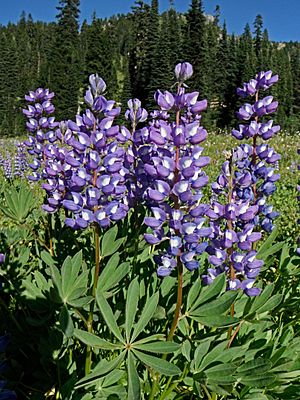Arctic lupine facts for kids
Quick facts for kids Arctic lupine |
|
|---|---|
 |
|
| Scientific classification | |
| Genus: |
Lupinus
|
| Species: |
arcticus
|
The Lupinus arcticus, also known as the Arctic lupine or subalpine lupine, is a beautiful flowering plant. It belongs to the legume family, which includes peas and beans. This plant grows naturally in northwestern North America. You can find it from Oregon all the way north to Alaska and east to Nunavut. It is a very common wild flower in British Columbia.
Contents
What Does the Arctic Lupine Look Like?
The Arctic lupine is a plant that lives for many years. It grows from a deep taproot, which is like a main root that goes straight down. Its stem stands upright and can reach up to 50 centimeters (about 20 inches) tall.
Leaves and Flowers
The leaves are dark green and have tiny hairs. They grow on rough, hairy stalks called petioles, which can be up to 17 centimeters long. Each leaf is made up of 3 to 9 smaller leaflets, like fingers on a hand. Each leaflet can be up to 6 centimeters long.
The flowers grow in a tall cluster called a raceme, which can be up to 15 centimeters long. This cluster can hold up to 30 flowers! The flowers are usually blue, but sometimes they can be purple or even white. The top petal of the pea-like flowers might have a hint of pink.
Seeds and Fruits
After the flowers bloom, the plant produces a fuzzy, greenish to blackish seed pod. This pod is called a legume and is about 2 or 3 centimeters long. Inside, you can find up to 10 black seeds with white speckles. Each seed is about half a centimeter long. Sometimes, the Arctic lupine can mix its genes with other Lupine species if they grow close together. This is called hybridizing.
Where Does the Arctic Lupine Grow?
This plant likes to grow in different kinds of places. You can find it in fields filled with sedge and moss. It also thrives in cold, high-up areas called alpine regions. It even grows on the hills of the Canadian Arctic Archipelago. The Arctic lupine prefers tundra areas and places where the ground is moist or wet.
Interesting Facts and Research
The Arctic lupine has been part of some exciting scientific discoveries.
The Mystery of the Oldest Seeds
In 1967, something amazing happened. Scientists found seeds of the Arctic lupine in very old burrows made by lemmings. These burrows were from the Pleistocene Ice Age, thousands of years ago! What made it even more exciting was that these ancient seeds actually sprouted and grew into plants. For a while, they were thought to be the oldest viable seeds ever found.
However, in 2009, more research was done. Scientists used a method called radiocarbon dating to figure out the real age of the seeds. It turned out the seeds were only a few years old when they were found. They had probably just fallen into the old lemming burrows not long before.
Plant Defenses
The Arctic lupine has a special way to protect itself from animals that might want to eat it. It produces a natural chemical called sparteine. This chemical is a neurotoxin, which means it can affect the nervous system. It probably helps keep animals like the snowshoe hare away.
Interestingly, the amount of sparteine in the plant's leaves changes throughout the day. It becomes higher at night, which is when animals are more likely to be looking for food. Besides snowshoe hares, some types of ground squirrels are also known to eat this plant.

